
Dudleya, commonly known as liveforevers is a genus of succulent plants in the stonecrop family, Crassulaceae, consisting of about 68 taxa in southwestern North America and Guadalupe Island. The species come in multiple forms, some large and evergreen, others cryptic and deciduous. The flowers of Dudleya have parts numbered in 5, and when fruiting are filled with tiny, ovoid or crescent-shaped seeds.

Dudleya abramsiisubsp. setchellii, known by the common name Dudleya setchellii, the Santa Clara Valley dudleya, or Santa Clara Valley liveforever, is a member of the Dudleya genus of succulent perennials, members of the family Crassulaceae. The Santa Clara Valley dudleya, endemic to the Santa Clara Valley region in the southern San Francisco Bay Area, was listed on 3 February 1995, as an endangered species. It is considered to be a subspecies of Dudleya abramsii, but its taxonomic status is still unclear. Its closest relative is Dudleya cymosa subsp. paniculata, which is a morphologically similar sister taxon.

Dudleya cymosa is a species complex of evergreen and deciduous succulent plants in the family Crassulaceae known by the common name: canyon liveforever. It is a loosely defined polyphyletic species with a diverse number of subspecies, varying highly in morphology, distribution, and habitat.

Dudleya blochmaniae is a summer-deciduous succulent plant known by the common names Blochman's liveforever or Blochman's dudleya. This species of Dudleya survives part of the year with no aboveground presence, surviving as underground corm-like roots in deciduous months. It is characterized by white, star-shaped and spreading flowers that emerge after sufficient rainfall. It is found along the Pacific coast of the California Floristic Province, from the vicinity of San Luis Obispo in California to Punta Colonet in Baja California.

Dudleya caespitosa is a succulent plant known by several common names, including sea lettuce, sand lettuce, and coast dudleya. It is endemic to California, where it grows along the coastline in the southern half of the state. Taxonomically, this species is a highly variable complex of polymorphic and polyploid plants, closely related to numerous neighboring species such as Dudleya farinosa, Dudleya greenei and Dudleya palmeri. It is delimited from neighboring species on an arbitrary basis of distribution and chromosome number, and may not be immediately separable from the other species it approaches.

Dudleya abramsiisubsp.calcicola is a succulent plant known by the common name limestone liveforever, or limestone dudleya. It is endemic to California, where it is a rare resident of limestone outcroppings and rocky slopes in the southern Sierra Nevada and nearby mountains and foothills. It was formerly regarded as Dudleya calcicola.

Dudleya candelabrum is a species of succulent plant known by the common names candleholder liveforever or candleholder dudleya. Endemic to California, this species grows wild only on the northern Channel Islands, where it is found in open rocky places and north-facing slopes. It is characterized by thin, spade-shaped green leaves and an inflorescence covered in long, reflexed bracts, with pale yellow flowers. It has been threatened by poachers shipping plants to South Korea.
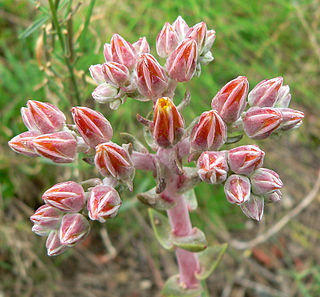
Dudleya palmeri is a species of succulent plant in the family Crassulaceae known by the common name Palmer's liveforever. This Dudleya is endemic to California where it grows along the coast. It is characterized by orange to red over yellow or pink flowers. It is a polyploid species that closely resembles Dudleya lanceolata but has a coastal habit, and hybridizes with Dudleya caespitosa and Dudleya cymosa.

Dudleya greenei is a perennial species of succulent plant known by the common names Greene's liveforever, or Greene's dudleya. It is endemic to the Channel Islands of California, where it grows along the cliffs of four of the eight islands. It is a highly variable plant, presenting with multiple forms and varying levels of ploidy. Taxonomically, this species is an insular segregate of Dudleya caespitosa, and was placed as a stopgap taxon by Reid Moran in his 1951 thesis on the genus. It is characterized by white or green leaf rosettes, loomed over by inflorescences bearing pale yellow to white flowers. It is a member of the subgenus Dudleya, as it cannot be propagated from leaf cuttings, does not grow from a corm, and has tight petals.
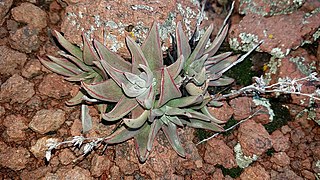
Dudleya abramsii is a species complex of succulent plants native to California and parts of Baja California. There are numerous subspecies, some critically endangered, with varying habits and lifestyles, but most often characterized by a smaller size, yellow flowers, and an affinity for rocky habitats. The subspecies may be polyphyletic.

Dudleya verityi is a rare species of succulent plant known by the common name Verity's liveforever. It is endemic to Ventura County, California, where it is known from only three occurrences in the vicinity of Conejo Mountain between Camarillo and Thousand Oaks. It probably occurs in a few additional locations nearby which have not yet been officially vouchered.
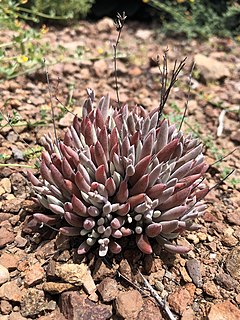
Dudleya attenuata is a species of perennial succulent plant known by the common name taper-tip liveforever, native to Baja California and a small portion of California. A rosette-forming leaf succulent, it has narrow pencil shaped leaves that can often be found covered in a white epicuticular wax. The thin, sprawling stems branch to form the clusters of rosettes, with plants creating a "clump" up to 40 cm wide. The small flowers are white or yellow, with 5 spreading petals. It is a diverse, variable species that extends from the southernmost coast of San Diego County to an area slightly north of the Vizcaino Desert, hybridizing with many other species of Dudleya in its range. Some plants with white or pinkish flowers were referred to as Orcutt's liveforever, referring to a former subspecies split on the basis of the flower color.
Dudleya formosa, known by the common name La Misión liveforever, is a species of perennial succulent plant endemic to the Guadalupe Valley in Baja California. It is characterized by bright green leaves, red floral stems, and pink flowers.

Dudleya abramsii subsp. abramsii is a species of succulent plant in the family Crassulaceae known by the common name as Abrams' liveforever. It is a small, delicate plant found growing among rocks, and is characterized by yellow flowers with a red tinge that emerge from May to July. It is native to the southern Sierra Nevada of California and the Peninsular Ranges across both the United States and Mexico.

Dudleya abramsii subsp. affinis, commonly known as the San Bernardino Mountains Dudleya, is a subspecies of succulent plant endemic to a portion of the San Bernardino Mountains in California. It is a plant with an unbranching stem and elliptical leaves occurring in Green Canyon and the nearby plateaus.
Dudleya cymosasubsp. costatifolia, known commonly as the Pierpoint Springs dudleya or the Pierpoint Springs liveforever, is a species of succulent plant in the family Crassulaceae, narrowly endemic to a locality in Tulare County, California, United States. It is a clumping plant with small rosettes and bright yellow flowers, resembling alpine "cushion plants."
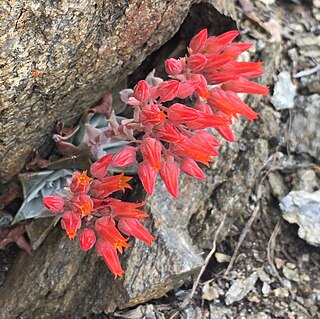
Dudleya cymosasubsp. pumila, most commonly known as the low canyon dudleya, chalky canyon dudleya or California live-forever, is a species of perennial succulent plant. It has diamond to spoon shaped leaves, sometimes coated with a fine white powder, and in May through July, bright red, orange or yellow flowers adorn the short inflorescence. A leaf succulent primarily found growing in rocky cliffs and slopes, it is endemic to California, and grows in the Transverse Ranges and South Coast Ranges, with some outlying populations. A variable plant, in some localities it is difficult to distinguish from other plants in the genus.

Dudleya cymosasubsp. cymosa is a species of succulent perennial plant in the family Crassulaceae native to California. It is the autonymous subspecies for Dudleya cymosa, and is known by the common name canyon liveforever. It is native to the California Coast Ranges, the Sierra Nevada and the Santa Monica Mountains. It is characterized by bright-yellow, orange or red flowers and broad, wide leaves. This plant is commonly found growing on rocky outcrops, talus slopes, and in shaded canyons.
Dudleya virens subsp. extima is a subspecies of succulent plant in the family Crassulaceae commonly known as the Guadalupe green liveforever. It is a rosette-forming leaf succulent, with both green and white waxy foliage. It has white flowers with spreading petals that bloom from May to June. It is a somewhat small plant, continuing a southward trend of decreasing size relative to other Dudleya virens subspecies. This plant is endemic to Guadalupe Island in the eastern Pacific Ocean, which is 241 kilometers off of the Baja California coast. It is very rare, with this plant only surviving on sheer cliff faces and canyons, out of the reach of the former feral goat population rampant on the island. It closely resembles a miniature version of Dudleya virens subsp. virens, but it may be more nearly related to the local Dudleya guadalupensis.
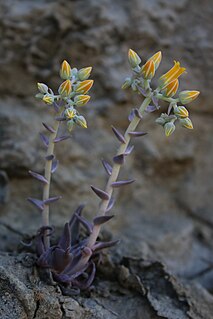
Dudleya cymosasubsp. agourensis, commonly known as the Agoura Hills dudleya or Agoura Hills liveforever, is a species of perennial succulent plant. A rare and critically imperiled species from the Santa Monica Mountains in California, it is characterized by glaucous, gray-purple leaves, bright yellow flowers, and ascending bracts. A leaf succulent, it is found growing on west to northwest-facing open, rocky volcanic slopes.





















